Plants
Polka Dot Plant Care: Our Ultimate Guide to Growing and Nurturing Hypoestes Phyllostachya
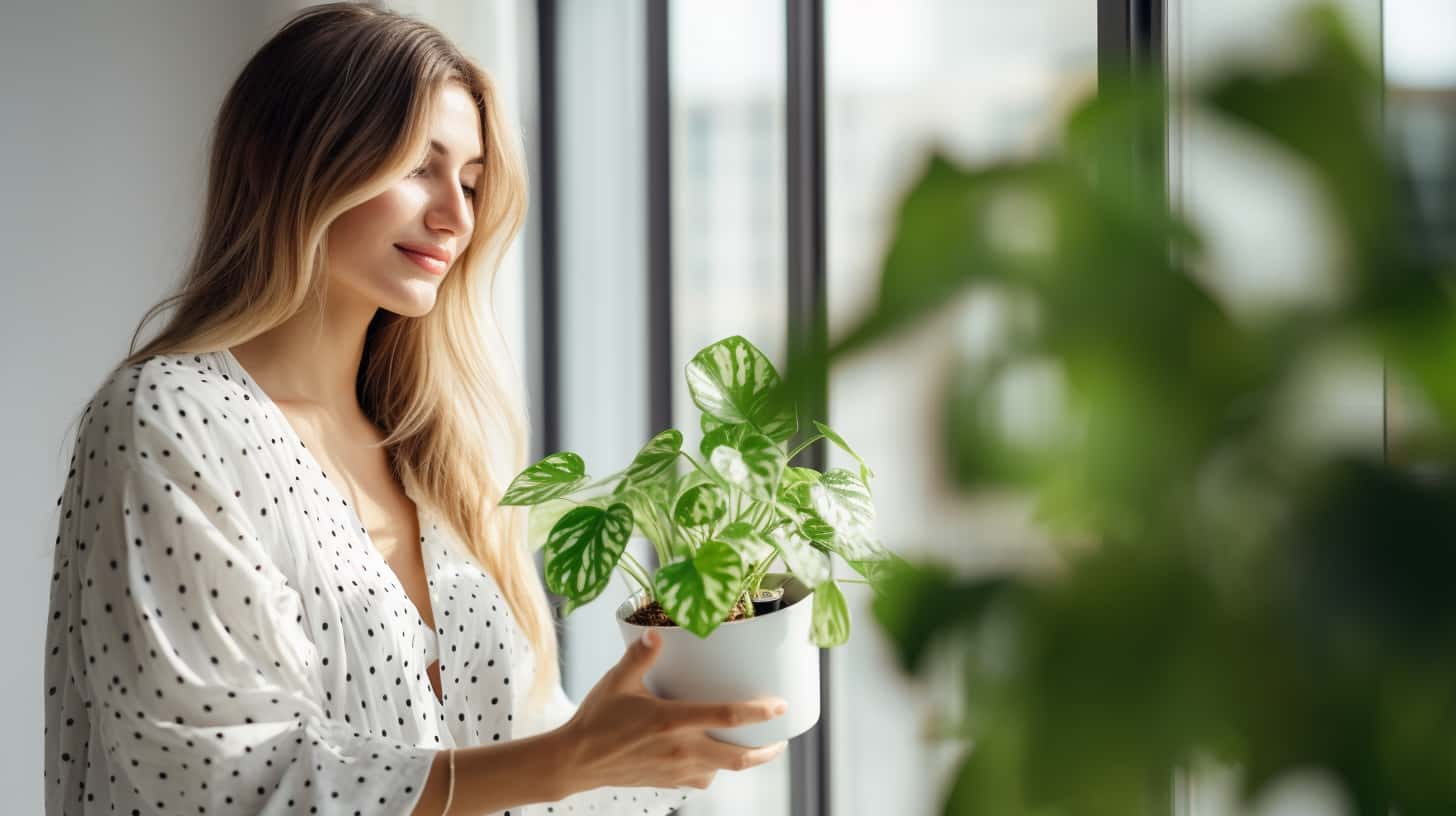
Ready to add a pop of color to your indoor space with some beautiful container plants? Whether you have limited outdoor space or simply prefer to plant indoors, these green foliage plants are perfect for bringing life and vibrancy to any room. Look no further than the polka dot plant!
With its vibrant foliage, this popular indoor plant is sure to brighten up any room. Whether you are a gardener or not, container plants like this one can also be enjoyed outdoors. Native to Madagascar, the polka dot plant, scientifically known as Hypoestes phyllostachya, thrives indoors as an indoor plant in tropical climates.
Its variegation adds a pop of color to any room, and it prefers bright sun for optimal growth. But don’t worry if you don’t live in a warm region during spring – we’ve got you covered with all the tips and tricks on how to care for your polka dot plant.

In this guide, we’ll walk you through everything you need to know about successfully growing and maintaining your polka dot plant. Whether you’re a seasoned gardener or just starting out, our expert advice will help you create the perfect environment for your plant to thrive. From finding the ideal spot to plant indoors and choosing the right container size, understanding signs of distress and proper watering techniques for your indoor plants, we’ve got it all covered.
Understanding Polka Dot Plants
Polka dot plants are an excellent choice. These plants have attractive leaves adorned with colorful spots or dots, making them a delightful addition to any home or office. The leaves of the polka dot plant can come in various shades, including pink, red, white, and green, allowing you to choose a variety that suits your aesthetic preferences.
Belonging to the Acanthaceae family, the polka dot plant is related to other popular houseplants like the nerve plant and fittonia. With proper care, these plants can live for several years, bringing beauty and liveliness to your surroundings. Whether you’re a seasoned plant enthusiast or just starting your indoor gardening journey, understanding the characteristics and optimal conditions for polka dot plants is essential for their successful growth.
Plant Characteristics
Polka dot plants are known for their unique foliage. The oval-shaped leaves of this plant indoors usually feature eye-catching spots or dots in contrasting colors. This distinctive pattern adds visual interest and makes them stand out among other houseplants. Depending on the variety, the size of polka dot plants can range from compact specimens suitable for small spaces to larger ones reaching heights of 12 to 18 inches.
These plants thrive indoors but can also be grown outdoors in warmer climates as annuals or perennials depending on the specific variety. Their longevity largely depends on how well they are cared for.
Optimal Conditions
To ensure healthy growth and vibrant foliage, it’s important to provide optimal conditions for your polka dot plant. Here are some key factors to consider:

Light: Polka dot plants prefer bright but indirect light conditions. Placing them near a window where they receive filtered sunlight is ideal. Avoid exposing them directly to harsh sunlight as it may scorch their delicate leaves.
Temperature: Maintaining temperatures between 65°F and 75°F is crucial for the optimal growth of polka dot plants. They thrive in warm environments but can tolerate slight temperature fluctuations.
Humidity: Polka dot plants originate from tropical regions, so they appreciate higher humidity levels. Aim to keep the humidity around 50% to 60% by misting the leaves regularly or using a humidifier. This mimics their natural habitat and helps prevent leaf browning or drying out.
Air Circulation: While high humidity is important, it’s equally essential to provide good air circulation. Avoid placing your polka dot plant in drafty areas or near heating vents as these conditions can lead to stress and damage the foliage.
Soil and Watering: Polka dot plants prefer well-draining soil that retains moisture without becoming waterlogged. A mixture of peat moss, perlite, and potting soil works well for their growth. Water your plant when the top inch of soil feels dry, being careful not to overwater as it can cause root rot.
Varieties to Grow
There are several popular varieties of polka dot plants available, each with its own unique leaf coloration and pattern. Some common varieties include Hypoestes phyllostachya ‘Splash Select’, ‘Pink Splash’, and ‘Confetti’. These varieties offer different combinations of colors, allowing you to choose one that suits your personal style and preferences.
Consider selecting a variety with contrasting leaf colors for a visually striking display. The vibrant hues of pink, red, white, and green will add a pop of color to any space. When choosing a variety, take into account the lighting conditions in your home to ensure that you can meet its specific requirements.
Starting Your Polka Dot Plant
There are a few important factors to consider.
Choosing Soil
The soil you choose for your polka dot plant is crucial for its overall health and growth. These plants prefer well-draining soil that retains moisture without becoming waterlogged. To create a suitable growing medium, we recommend using a mixture of peat moss, perlite, and potting soil.
Avoid using heavy clay-based soils as they can lead to root rot and other issues. Adding organic matter like compost can improve the soil’s fertility and drainage capabilities. It also helps provide essential nutrients for the plant’s growth.

Regularly check the moisture level of the soil to ensure it remains consistently moist but not overly saturated. This will help prevent waterlogging and keep your polka dot plant healthy.
Potting Guidelines
When potting your polka dot plant, it’s important to choose the right container and follow proper guidelines. Select a pot with drainage holes to prevent waterlogging and allow excess water to escape.
Use a pot that is slightly larger than the current root ball of your polka dot plant. This will give it enough room for growth without overwhelming it with too much space. Gently loosen the roots before placing the plant in the new pot to encourage healthy root development.
Fill the pot with the prepared soil mix, ensuring that it is evenly distributed around the roots. Press down gently to secure the plant in place. After potting, water thoroughly to settle the soil and provide initial hydration to your newly potted polka dot plant.
Light Requirements
Polka dot plants thrive in bright, indirect light conditions. They do not tolerate direct sunlight well as it can scorch their delicate leaves. When positioning your polka dot plant, consider placing it near a north or east-facing window. This will provide sufficient light without risking sunburn.
If natural light is limited in your space, you can supplement with artificial grow lights to ensure adequate brightness for proper growth. Regularly rotate your polka dot plant to promote even growth and prevent it from leaning towards the light source.

Remember that each polka dot plant may have slightly different light requirements, so it’s essential to observe how your plant responds and adjust accordingly. By providing the right amount of light, you can help your polka dot plant thrive and maintain its vibrant foliage.
Nurturing Your Plant
Taking care of your polka dot plant is essential to ensure its health and vibrant growth. From watering techniques to temperature and humidity requirements, here are some tips to help you nurture your plant effectively.
Watering Techniques
Proper watering is crucial for the well-being of your polka dot plant. Here are some techniques to keep in mind:
-
Water your polka dot plant when the top inch of soil feels dry to the touch. This ensures that the roots have access to moisture without becoming waterlogged.
-
Overwatering can lead to root rot and other moisture-related issues, so it’s important not to water too frequently or excessively.
-
When watering, use room temperature water. Using cold water can shock the plant’s roots and hinder its growth.
-
Make sure to water thoroughly until excess water drains out of the bottom of the pot. This ensures that the entire root ball is adequately hydrated.
-
Environmental conditions such as temperature and humidity levels can affect how often you need to water your polka dot plant. Adjust your watering frequency accordingly.
Fertilizing Tips
Feeding your polka dot plant with the right nutrients is essential for promoting healthy growth. Here are some tips for fertilizing your plant:
-
During the growing season, feed your polka dot plant with a balanced liquid fertilizer diluted to half strength every two weeks. This provides a steady supply of nutrients for optimal growth.
-
In winter, when the plant enters its dormant period, reduce fertilization frequency to once a month.
-
Be cautious not to overfertilize your polka dot plant, as this can cause leaf burn and nutrient imbalances. Follow the instructions provided by the fertilizer manufacturer for proper dosage and application methods.
-
Consider using a slow-release fertilizer for long-term nutrient supply without the need for frequent applications.
Temperature and Humidity
Creating an environment that mimics their native tropical habitat is crucial for the well-being of polka dot plants. Here’s what you need to know about temperature and humidity:
-
Polka dot plants thrive in temperatures between 65°F and 75°F. It’s important to keep them away from cold drafts and areas with inconsistent temperatures.
-
Maintaining a humidity level of around 50% to 60% is ideal for your polka dot plant. This can be achieved by using a humidifier or placing a tray filled with water near the plant.
-
To provide additional moisture and create a more humid microclimate, mist the leaves occasionally.
Pruning and Maintenance
Pruning is an essential part of maintaining the health and appearance of your polka dot plant. By regularly pruning your plant, you can ensure that it stays in shape and looks its best. One important aspect of pruning is removing any yellowing or dead leaves promptly. This not only improves the overall aesthetics but also prevents the spread of diseases.
Another technique for pruning your polka dot plant is to pinch back leggy stems. By doing so, you encourage bushier growth and promote a fuller appearance. This can be especially helpful if your plant starts to look sparse or uneven. Simply use your fingers or a pair of clean, sterilized scissors to pinch off the ends of the stems.
In addition to removing yellowing leaves and pinching back leggy stems, it’s also important to prune away any overcrowded or crossing branches. This helps improve air circulation around the plant and reduces the risk of pests and diseases. When pruning, make sure to use clean, sterilized tools to prevent the transmission of pathogens between plants.

Repotting your polka dot plant is another crucial aspect of its maintenance routine. It’s generally recommended to repot your plant every 1 to 2 years or when it outgrows its current container. When repotting, choose a pot that is one size larger than the current one to allow for root growth.
To repot your polka dot plant, gently remove it from its current pot, being careful not to damage the roots. Once removed, loosen the root ball by gently teasing apart some of the roots with your fingers. Trim any damaged or excessively long roots before placing the plant in its new pot filled with fresh soil. After repotting, water thoroughly to help settle the soil around the roots.
During winter months, polka dot plants enter a period of dormancy where their growth slows down significantly. As such, overwintering strategies are necessary to ensure the plant’s well-being. One important aspect of overwintering is reducing the frequency of watering. Since the plant is not actively growing, it requires less water during this time.
It’s also crucial to keep your polka dot plant away from cold drafts and maintain a consistent temperature between 60°F and 65°F. Cold drafts can cause stress and damage to the plant, so it’s best to place it in a protected area of your home. If necessary, you can provide additional humidity by placing a tray filled with water near the plant or using a humidifier.
During the dormant period, it’s advisable to avoid fertilizing your polka dot plant. Fertilizers provide nutrients that promote growth, but since the plant is not actively growing during winter, it doesn’t require additional nutrients at this time. Allowing the plant to rest and conserve energy during winter months helps prepare it for new growth when spring arrives.

Lastly, it’s essential to monitor your polka dot plant closely for any signs of stress or pest infestation during winter months. The reduced light levels and dry indoor air can make plants more susceptible to issues like spider mites or fungal diseases. Regularly inspect your plant for any abnormalities and take appropriate action if needed.
Propagation Methods
There are a couple of propagation methods we can try: cuttings and division. Both methods are relatively easy and can be done by any plant enthusiast.
Cuttings and Division
Propagating polka dot plants through stem cuttings is a popular method among plant lovers. To get started, we need to take 3 to 4-inch stem cuttings just below a leaf node. It’s important to make sure that each cutting has at least two sets of leaves for successful propagation.
After taking the cuttings, we remove the lower leaves from each cutting. This helps direct the plant’s energy towards root development rather than sustaining unnecessary foliage. To further encourage root growth, we dip the cut end of each stem in rooting hormone powder. This powder contains hormones that stimulate root formation.
Once the stems are prepared, it’s time to plant them in a well-draining soil mix. Polka dot plants prefer soil that retains some moisture but doesn’t become waterlogged. We make sure to provide adequate drainage for our cuttings by using a mix that allows excess water to flow out easily.
To create an ideal environment for our newly planted cuttings, we keep them in a warm and humid spot. A humidity dome or plastic bag can help maintain the necessary moisture levels around the plants. We also ensure they receive indirect light during this stage as direct sunlight may scorch their delicate leaves.
Over time, roots will start to form from the base of each cutting. Once these roots have developed sufficiently, usually after a few weeks, we can transplant our new polka dot plants into individual pots or combine them into larger containers if desired.
Another way to propagate polka dot plants is through division. This method involves separating mature plants into smaller sections during repotting. When repotting our polka dot plant, we carefully separate rooted sections and replant them in their own containers.
Encouraging Growth
To promote healthy growth in our polka dot plants, we need to provide them with regular care and maintenance. Here are a few key factors to consider:
-
Light: Polka dot plants thrive in bright, indirect light. Placing them near a window where they can receive filtered sunlight is ideal. If the plant starts leaning towards the light source, we rotate it periodically to ensure even exposure.
-
Water: It’s important to water our polka dot plants regularly but avoid overwatering. We allow the top inch of soil to dry out slightly between watering sessions to prevent root rot. The frequency of watering may vary depending on environmental conditions such as temperature and humidity.
-
Nutrients: Polka dot plants benefit from regular feeding during the growing season. We use a balanced liquid fertilizer diluted according to the package instructions. Applying fertilizer once every two weeks helps provide essential nutrients for healthy foliage growth.
-
Pruning: Regular pruning is necessary to maintain the shape and overall health of our polka dot plants. We remove any dead or yellowing leaves by simply snipping them off at the base using clean pruning shears or scissors. This encourages new growth and prevents disease spread.
-
Repotting/Division: Over time, our polka dot plants may outgrow their current containers or become crowded with roots. When this happens, we repot them into larger pots or divide them into smaller sections during repotting, creating more space for new growth.
Troubleshooting Common Issues
Pests and Diseases
Pests and diseases can sometimes affect our beloved polka dot plants, but with proper care and attention, we can keep them healthy and thriving. Some common pests that may trouble polka dot plants include aphids, spider mites, and mealybugs. These tiny insects can cause damage to the leaves by sucking out sap or leaving behind a sticky residue.
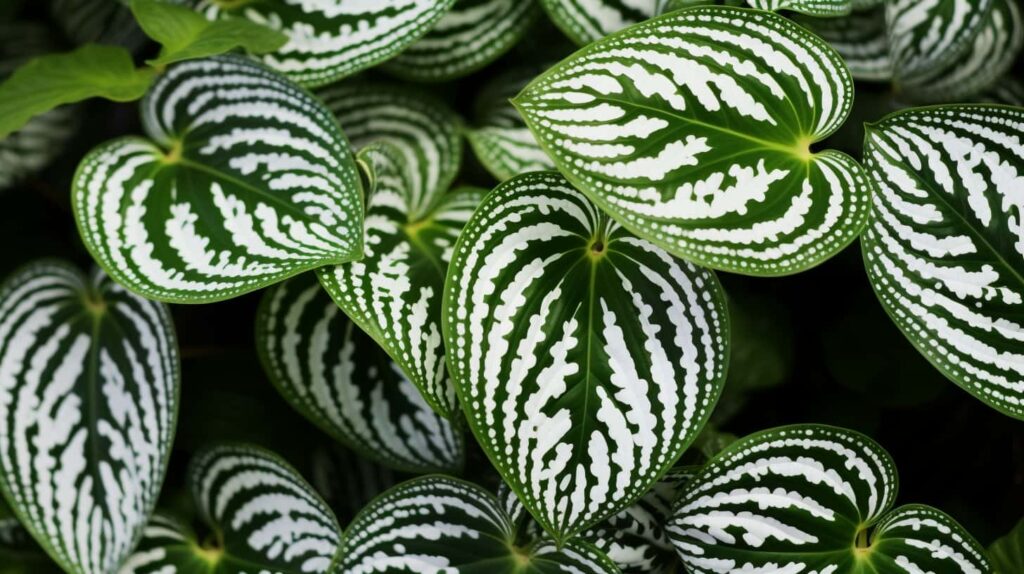
To prevent pest infestations, it’s essential to regularly inspect your plant for any signs of trouble. Look out for webbing, sticky residue on the leaves, or distorted growth. If you notice any of these symptoms, it’s time to take action.
Treating pest problems in polka dot plants can be done using organic insecticidal soap or neem oil. These natural remedies are safe for the plant and effective against common pests. Follow the instructions provided by the manufacturer when applying these treatments to ensure their efficacy.
While polka dot plants are generally resistant to diseases, they can develop issues like root rot if overwatered or exposed to poorly draining soil. To avoid such problems, make sure you provide your plant with well-draining soil and water it appropriately. Overwatering can lead to soggy roots and create a favorable environment for fungal growth.
Browning Leaves
If you notice browning leaves on your polka dot plant, several factors could be contributing to this issue. Underwatering is one possible cause; check the moisture level of the soil by sticking your finger into it. If it feels dry below the surface, it’s time to water your plant.
On the other hand, overwatering can also lead to browning leaves due to root rot caused by excess moisture in the soil. Adjust your watering frequency accordingly based on the needs of your plant.
Another factor that affects leaf health is humidity levels. Polka dot plants thrive in humid environments; therefore, it’s crucial to ensure they receive adequate humidity. You can mist the leaves regularly or use a humidifier to increase moisture in the air around your plant.
Avoid exposing your polka dot plant to direct sunlight or cold drafts, as these can cause leaf browning. Find a suitable spot for your plant where it can receive bright, indirect light without being subjected to extreme temperature fluctuations.
If you notice severely damaged leaves on your polka dot plant, don’t hesitate to remove them. This will not only improve the overall appearance of the plant but also prevent further damage from spreading.
Drooping Foliage
Drooping foliage is often an indication of underwatering or excessive dryness in the environment. If you notice your polka dot plant’s leaves drooping, check the moisture level of the soil. If it feels dry to the touch, it’s time to water thoroughly and ensure that water reaches all parts of the root system.
Increasing humidity levels around your polka dot plant can also help revive drooping foliage. Misting the leaves with water or placing a tray filled with water nearby can create a more favorable environment for your plant.

Avoid placing your polka dot plant in areas with low humidity or near heating vents that can cause excessive dryness. These conditions can lead to dehydration and further contribute to drooping foliage.
If despite proper care, including adequate watering and humidity levels, the drooping persists, inspect the roots for signs of rot or other issues. Gently remove the plant from its pot and examine the roots for any mushy or discolored sections. Trim away any affected roots and repot your polka dot plant using fresh soil.
Enhancing Plant Vitality
To truly enhance the vitality of our polka dot plant, we need to focus on a few key aspects: encouraging blooming, cultivating for bushiness, and exploring companion planting options.
Encouraging Blooming
Polka dot plants are known for their vibrant foliage rather than their flowers. However, under optimal growing conditions, they can produce small and inconspicuous blooms. If you want your polka dot plant to bloom, here are some tips:
-
Provide bright, indirect light: Polka dot plants thrive in bright but indirect light. Place them near a window where they can receive plenty of natural light without being exposed to direct sunlight.
-
Maintain stable temperatures: These plants prefer temperatures between 65°F and 75°F (18°C – 24°C). Avoid exposing them to extreme temperature fluctuations or drafts.
-
Avoid overfertilizing: While fertilizing is important for overall plant health, excessive nitrogen can lead to an abundance of leaf growth at the expense of flower production. Use a balanced fertilizer and follow the recommended dosage.
-
Prune regularly: Removing spent flowers not only keeps your plant looking tidy but also encourages new growth. Pruning stimulates the plant to redirect its energy towards producing more blooms.
Cultivation for Bushiness
If you want your polka dot plant to have a bushy appearance with lush foliage, regular pruning is essential. Follow these steps to cultivate bushiness:
-
Pinch back leggy stems: When you notice long and spindly stems, pinch them back using your fingers or sharp pruning shears. This technique encourages branching and promotes a fuller growth habit.
-
Remove overcrowded or crossing branches: Over time, some branches may become overcrowded or cross each other’s paths. Removing these branches improves air circulation around the plant and prevents disease development.
-
Provide sufficient light: Polka dot plants need adequate light to thrive. Ensure that each leaf receives enough sunlight for photosynthesis by placing the plant in a well-lit area. Avoid overcrowding, as it can limit light penetration.
-
Consider balanced fertilization: Balanced fertilizers contain equal amounts of nitrogen, phosphorus, and potassium. These essential nutrients support healthy foliage growth and overall plant vitality.
Companion Planting
Companion planting is an excellent way to create visually appealing displays and enhance the overall aesthetic of your indoor garden. When choosing companion plants for your polka dot plant, consider the following:
-
Contrasting foliage colors or textures: Pair your polka dot plant with other houseplants that have contrasting foliage colors or textures. This contrast adds visual interest and makes your display more captivating.
-
Suitable companion plants: Ferns, calatheas, pothos, and snake plants are great options to pair with polka dot plants. These plants complement each other well in terms of care requirements and appearance.
-
Similar light and moisture requirements: To ensure harmonious growth, select companion plants that have similar light and moisture requirements as your polka dot plant. This helps avoid conflicting care needs and ensures all plants thrive together.
-
Monitor growth regularly: As time goes on, some companion plants may grow faster than others or become overcrowded. Regularly monitor their growth to prevent competition for resources or overshadowing of the polka dot plant.
Safety and Precautions
Safety is always a top priority. We want to ensure that the plants we choose are safe for both humans and pets.
Toxicity Levels
The good news is that polka dot plants are considered non-toxic to humans and pets. This makes them an excellent choice for households with children or animals. You can enjoy the beauty of these vibrant plants without worrying about any harmful effects.
However, it’s important to note that while polka dot plants may be non-toxic, it’s still advisable to keep them out of reach of curious pets or young children. Accidental ingestion can sometimes occur, especially if your furry friend or little one has a penchant for nibbling on things they shouldn’t.
If you suspect that your pet has ingested any part of the polka dot plant and displays unusual symptoms such as vomiting or diarrhea, it’s crucial to consult a veterinarian immediately. They will be able to provide proper guidance and care for your beloved pet.
While polka dot plants are generally safe for most people, some individuals may have skin sensitivity to the sap of the plant. If you notice any irritation or allergic reactions after handling the plant, it’s best to wear gloves as a precautionary measure. Gloves will protect your hands from direct contact with the sap and minimize any potential discomfort.
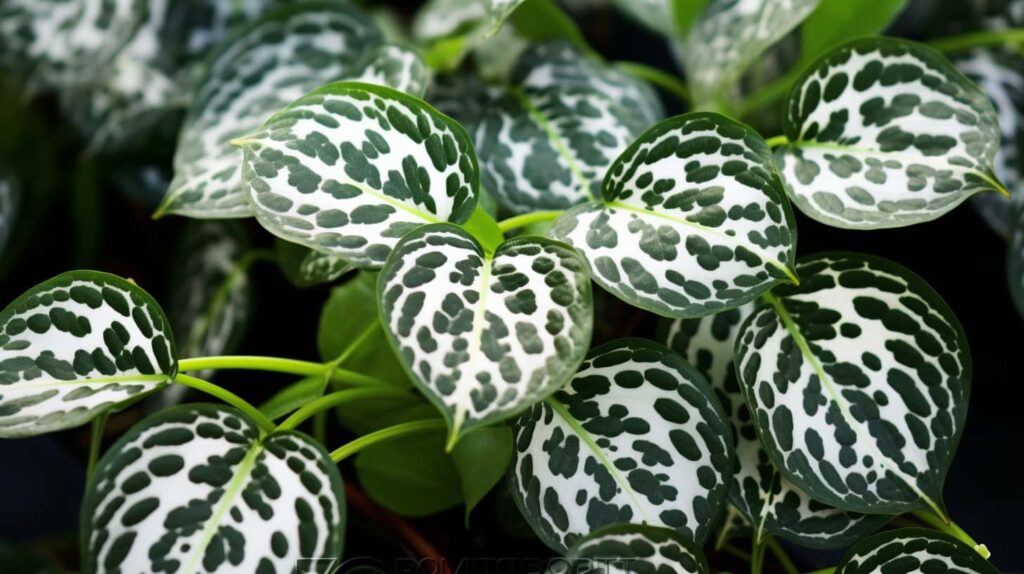
Overall,The polka dot plant is a low-risk option for indoor gardening enthusiasts. Just remember to exercise caution around curious pets and young children and take necessary measures if allergies or sensitivities arise.
Handling Precautions
To ensure the long-term health and aesthetic appeal of your polka dot plant, proper handling is essential. Here are some precautions you should keep in mind:
-
Be cautious of delicate leaves and stems: Polka dot plants have delicate foliage, so it’s crucial to handle them with care. Avoid touching or rubbing the leaves excessively, as this can cause discoloration or bruising.
-
Wash your hands after handling: After interacting with your polka dot plant, make sure to wash your hands thoroughly. This will help remove any potential allergens or irritants from the sap and prevent any adverse reactions.
-
Use clean, sharp pruning tools: If you need to prune your polka dot plant, use clean and sharp pruning tools. This will ensure a clean cut and minimize damage to the plant. Before and after each use, sterilize the tools to prevent the spread of diseases between plants.
Design and Aesthetics
We always look for options that not only add a touch of nature but also enhance the overall aesthetics of our space. One plant that can help achieve this is the polka dot plant. With its vibrant colors and unique leaf patterns, the polka dot plant can be a great addition to any home or office.
Colorful Design Ideas
One of the best things about polka dot plants is their colorful foliage, which opens up endless design possibilities. To create a vibrant display, we can combine different varieties of polka dot plants with contrasting leaf colors. For example, pairing a pink polka dot plant with a green one creates an eye-catching arrangement that adds visual interest to any room.
To further enhance the design, we can also consider pairing polka dot plants with other plants that have complementary foliage patterns or textures. This combination creates a dynamic display by playing with different shapes and forms. For instance, placing a variegated pothos next to a polka dot plant with large spots can create an interesting contrast in leaf sizes and patterns.
In addition to choosing the right plants, we can also experiment with decorative containers in bold colors or patterns. By using containers that match our personal style or complement our existing decor, we can elevate the overall aesthetic appeal of the display even more. Whether it’s a vibrant red pot or one adorned with intricate designs, these containers will make our polka dot plants stand out as focal points in any room.
Lastly, don’t be afraid to play around with different heights and arrangements when displaying your polka dot plants. Mixing taller varieties with shorter ones or creating layered displays using shelves or hanging baskets adds depth and dimension to your space. By varying heights and arrangements based on personal preference, you’ll be able to create a dynamic display that suits your unique style.
Pairing with Companions
While polka dot plants are beautiful on their own, they can also be paired with other companion plants to create visually appealing combinations. By choosing the right companions, we can enhance the overall appeal of our indoor garden.
Trailing plants like pothos or ivy make excellent companions for polka dot plants. Their cascading foliage adds depth and a sense of movement to the display. By placing them in hanging baskets or allowing them to trail down from shelves, we can create a lush and vibrant arrangement that is pleasing to the eye.
For those looking to add height variation and architectural interest, pairing polka dot plants with upright plants such as snake plants or peace lilies is a great option. The tall and structured nature of these companions creates an interesting contrast against the soft and playful appearance of the polka dot plant.
When selecting companion plants, it’s important to consider their care requirements. Choosing plants that have similar needs in terms of light, water, and humidity ensures that they will thrive together in the same environment. This way, we can create a harmonious display where all the plants are happy and healthy.
Experimentation is key. Don’t be afraid to try different combinations until you find one that complements your plant’s unique characteristics while creating a visually stunning display.
Care Tips for Longevity
Taking care of your polka dot plant (Hypoestes phyllostachya) is essential to ensure its longevity and keep it thriving.
General Care Guidelines
To provide the best conditions for your polka dot plant, follow these general care guidelines:
1. Provide Bright, Indirect Light: Polka dot plants prefer bright, indirect light. Place them near a window where they can receive filtered sunlight throughout the day. Avoid exposing them to direct sunlight, as it can scorch their delicate leaves.
2. Maintain Optimal Temperature and Humidity: Keep the temperature between 65°F and 75°F (18°C – 24°C) for optimal growth. Maintain a humidity level of around 50% to 60%. You can increase humidity by placing a tray filled with water near the plant or using a humidifier.
3. Water Appropriately: Water your polka dot plant when the top inch of soil feels dry to the touch. Ensure that the pot has proper drainage to prevent waterlogging, which can lead to root rot. Overwatering should be avoided as it can cause leaf drop and other issues.
4. Fertilize Regularly: During the growing season, fertilize your polka dot plant every two weeks with a balanced liquid fertilizer diluted to half strength. This will provide essential nutrients for healthy growth and vibrant foliage.
5. Prune Regularly: Regular pruning is important for maintaining the shape of your polka dot plant and encouraging bushier growth. Remove any dead or yellowing leaves promptly to promote new growth and prevent disease spread.
Blooming Tips
While polka dot plants are primarily grown for their attractive foliage, they can also produce small flowers under ideal conditions. Here are some tips on how to encourage blooming:
1. Provide Bright, Indirect Light: Similar to general care guidelines, polka dot plants need bright, indirect light to bloom. Place them in a location where they can receive adequate light without direct exposure to the sun.
2. Maintain Stable Temperatures: Polka dot plants prefer stable temperatures between 65°F and 75°F (18°C – 24°C). Avoid exposing them to extreme temperature fluctuations, as this can hinder flower production.
3. Avoid Overfertilizing: While fertilization is important for overall plant health, excessive nitrogen can promote leaf growth at the expense of flower production. Use a balanced fertilizer and avoid overfertilization to ensure a balance between foliage and blooms.
4. Remove Spent Flowers: Once your polka dot plant has produced flowers, it’s important to remove spent blooms promptly. This redirects energy towards new growth and potential future blooms.
5. Be Patient: It’s important to note that polka dot plants may not produce consistent or abundant flowers compared to other flowering houseplants. Don’t be discouraged if you don’t see blooms frequently; instead, enjoy their vibrant foliage.
Advanced Care Techniques
There are some advanced techniques that can help address complications and maximize flower production. Let’s dive into these strategies to ensure your plant thrives.
Addressing Complications
If you notice that your polka dot plant is not thriving as expected, it’s important to assess its care routine and environment for potential issues. Start by checking the moisture level of the soil to determine if underwatering or overwatering is causing problems. Adjust your watering schedule accordingly to provide the right amount of moisture for your plant.
Inspect the leaves of your polka dot plant for any signs of pests or diseases. Common pests that may affect this plant include spider mites, aphids, and mealybugs. If you spot any pests, treat them promptly with appropriate insecticides or organic pest control methods.
Another factor to consider is lighting conditions. Polka dot plants prefer bright but indirect light. Too much direct sunlight can lead to leaf burn, while insufficient light can cause leggy growth and a lack of vibrant colors in the foliage. Evaluate the location of your plant and make adjustments as needed to ensure it receives adequate brightness without direct exposure to harsh sunlight.
By addressing these potential complications and making necessary adjustments in care practices, you can improve overall plant health and encourage better growth.
Maximizing Flower Production
While polka dot plants are primarily known for their attractive foliage, they do have the potential to produce flowers under optimal growing conditions. To maximize flower production, follow these tips:
-
Provide bright but indirect light: Polka dot plants require sufficient light for healthy flower development. Place them near a window where they can receive bright light throughout the day without being exposed to direct sunlight.
-
Maintain stable temperatures: These plants thrive in temperatures between 65°F and 75°F (18°C-24°C). Avoid exposing them to extreme temperature fluctuations or drafts, as this can hinder flower production.
-
Avoid overfertilizing: While fertilization is important for overall plant health, excessive nitrogen can inhibit flower production in polka dot plants. Use a balanced fertilizer and follow the recommended dosage to avoid overfeeding your plant.
-
Regular pruning: Pruning is essential to remove spent flowers and encourage new growth, which may lead to additional blooms. Trim back any wilted or faded flowers to promote continuous flowering throughout the growing season.
Conclusion
And that’s a wrap on our journey with the polka dot plant! We’ve covered everything from understanding this vibrant houseplant to nurturing it, pruning and propagating it, troubleshooting common issues, and even exploring advanced care techniques. It’s been quite an adventure, hasn’t it?
As we bid farewell to our polka dot plants, let’s take a moment to reflect on the beauty and joy they bring to our lives. These little bursts of color have the power to transform any space into a lively oasis. So why not invite some plant friends into your home? Whether you’re a seasoned plant parent or just starting out, the polka dot plant is a wonderful addition to any collection.
Remember, caring for plants is not just about tending to their needs; it’s also about connecting with nature and finding solace in their presence. So go ahead, get your hands dirty, and embark on your own plant journey. We hope our guide has inspired you to explore the world of polka dot plants and discover the wonders of indoor gardening.
How is the Care for Kalanchoe Different from Polka Dot Plants?
When cultivating vibrant kalanchoe plants, it’s important to remember that they require less water compared to polka dot plants. Kalanchoe prefers dry soil and lots of sunlight, while polka dot plants need consistently moist soil and partial shade. Understanding these differences in care is crucial for successful plant growth.
Frequently Asked Questions
Can polka dot plants be grown indoors?
Yes, polka dot plants can be grown indoors. They thrive in bright, indirect light and require a temperature range of 65-75°F (18-24°C). Just make sure to place them away from drafts and provide adequate humidity levels.
How often should I water my polka dot plant?
Polka dot plants prefer consistently moist soil. Water them when the top inch of soil feels dry to the touch. Avoid overwatering as it can lead to root rot, but also ensure that the soil doesn’t completely dry out between waterings.
Can I propagate my polka dot plant?
Yes, you can easily propagate your polka dot plant through stem cuttings. Simply take a healthy stem cutting just below a leaf node, remove the lower leaves, and place it in water or moist soil. Keep it warm and humid until roots develop.
What are some common issues faced by polka dot plants?
Common issues with polka dot plants include yellowing leaves (indicating overwatering or nutrient deficiencies), leggy growth (insufficient light), and powdery mildew (caused by high humidity and poor air circulation). Proper watering, lighting, and ventilation can help prevent these problems.
How do I enhance the vitality of my polka dot plant?
To enhance your polka dot plant’s vitality, provide it with bright but indirect light, maintain proper humidity levels around 50-60%, fertilize every 2-4 weeks during the growing season with a balanced houseplant fertilizer, and regularly pinch back its stems to encourage bushier growth.
- About the Author
- Latest Posts
Meet Katherine, the creative enthusiast at ByRetreat who infuses her boundless passion for design into every remote workspace she crafts. With an innate sense of creativity and an eye for unconventional beauty, Katherine brings a unique and inspiring perspective to the team.
Katherine’s love for design is infectious, and her ability to think outside the box sets her apart. She believes that true artistry lies in embracing a variety of styles and mixing them harmoniously to create captivating spaces. By combining different textures, colors, and patterns, Katherine weaves a tapestry of creativity that breathes life into each remote workspace.
Plants
Ideal Hydrangea Spots: Best Place to Plant Hydrangeas
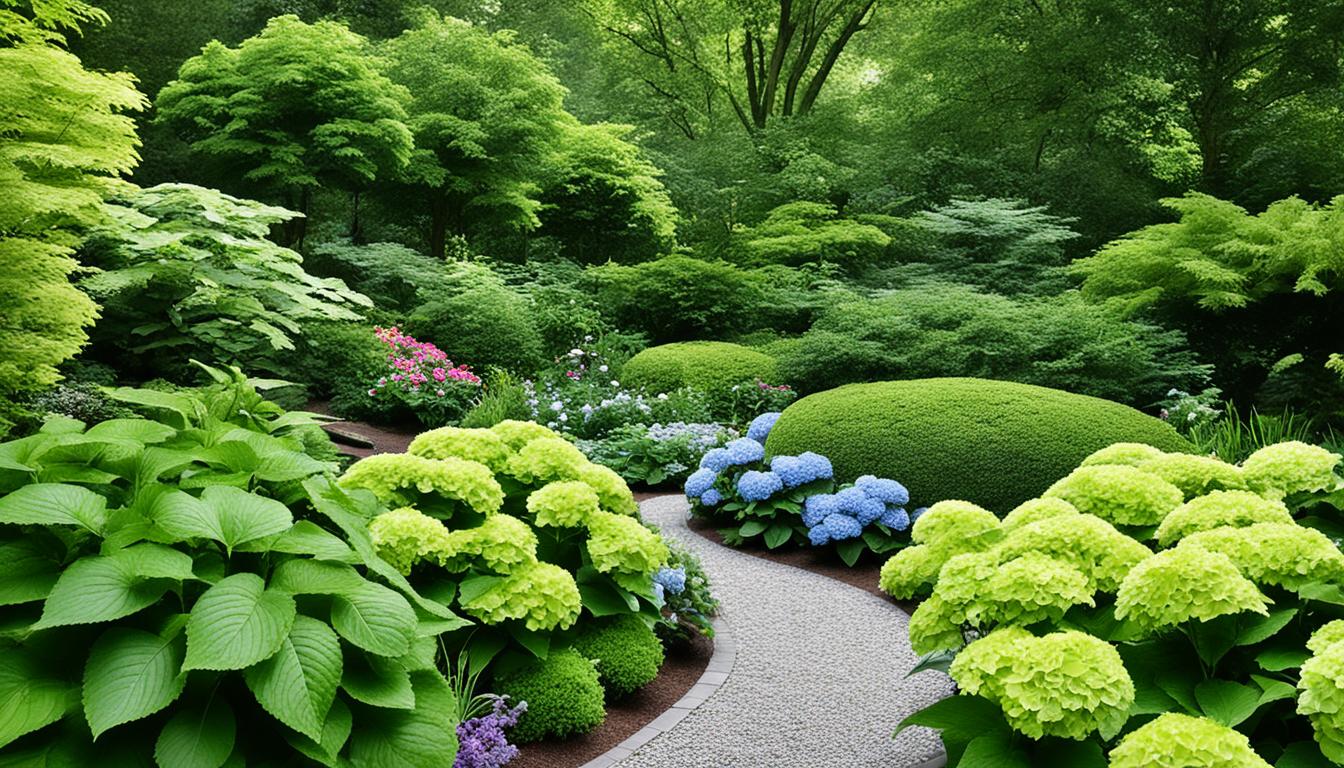
Did you know that the location where you plant your hydrangeas can have a significant impact on their growth and vibrancy? Finding the best place to plant hydrangeas is essential for optimal growth and to ensure that you get the most beautiful blooms.
In this guide, we will explore the different factors to consider when selecting the ideal spot for your hydrangeas. Whether you have a sunny garden or a shady corner, we’ll help you choose the right hydrangea varieties to thrive in various sun and shade conditions. By understanding their sunlight preferences and caring for them properly, you can enjoy vibrant and healthy hydrangea blooms year after year.
Key Takeaways:
- Choosing the right location is crucial for the growth and vibrancy of hydrangeas.
- Hydrangeas can thrive in different sunlight conditions, from full sun to partial shade.
- Consider the specific sunlight needs of different hydrangea varieties for optimal results.
- Proper care, including pruning, fertilizing, and watering, is essential for healthy blooms.
- By following our planting guide and care tips, you can transform your garden with stunning hydrangea displays.
Hydrangeas for Part Shade: Give Us Some Sunblock Please
When it comes to creating the perfect environment for hydrangeas, finding the right balance of sun and shade is key. While some hydrangea varieties thrive in full sun, others prefer a location with partial shade, where they can benefit from the morning sun and enjoy relief from the scorching afternoon rays. These hydrangeas are like beachgoers who know the importance of sunblock, seeking a little shade to protect themselves from the intense heat.
In the family of hydrangeas, there are several popular cultivars that are well-suited for part shade conditions. These varieties have the ability to produce stunning blooms when provided with a combination of filtered light and a few hours of full sun. Among them are the beloved Endless Summer® Hydrangea series, which includes BloomStruck®, Endless Summer®, Blushing Bride®, and Twist-n-Shout®.
Another great choice for morning sun and afternoon shade is the Annabelle Hydrangea, which is known for its spectacular large white flowers. And let’s not forget the many bigleaf hydrangea cultivars that can handle part shade and reward you with their vibrant blossoms.
Here are a few remarkable hydrangea varieties that thrive in part shade:
| Hydrangea Variety | Light Requirements |
|---|---|
| Endless Summer® series (BloomStruck®, Endless Summer®, Blushing Bride®, Twist-n-Shout®) | Morning sun, afternoon shade |
| Annabelle Hydrangea | Morning sun, afternoon shade |
| Bigleaf hydrangea cultivars | Morning sun, afternoon shade |
These hydrangeas have adapted to thrive in part shade by enjoying the gentle morning sun and being sheltered from the intense afternoon heat. This combination of light conditions allows them to produce their enchanting blooms and add a touch of elegance to any garden or landscape.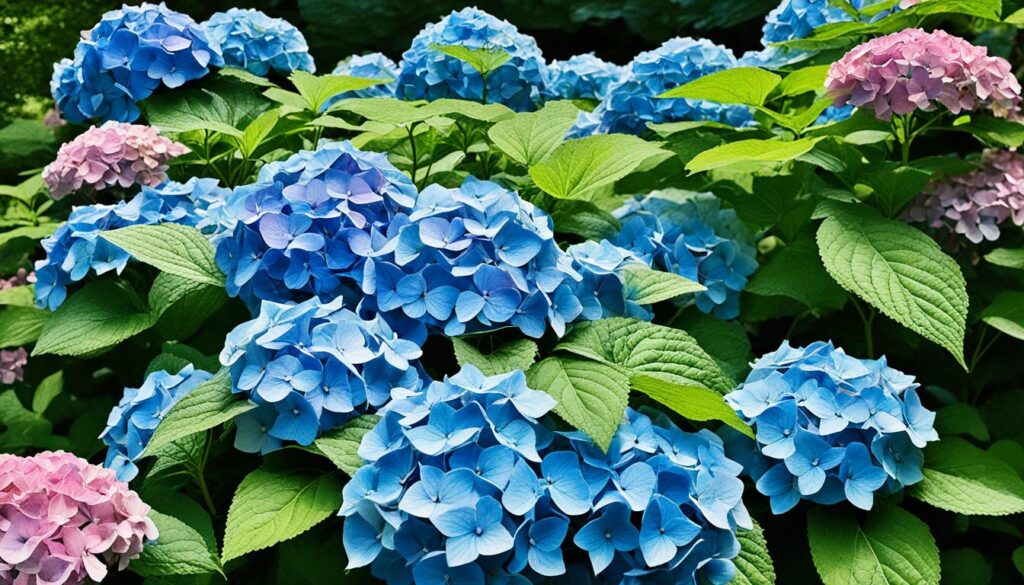
So, if you have a garden or yard with a mix of sunlight and shade, don’t worry! There are plenty of beautiful hydrangeas that will thrive in this environment. Just give them some sunblock (in the form of morning sun) and watch as their blooms light up your space with their breathtaking beauty.
Hydrangeas for Full Sun: We Like It Sunny
While most hydrangeas prefer some shade, there are certain varieties that can thrive in full sun. If your garden gets plenty of sunlight, don’t worry! There are hydrangeas that will flourish in these conditions and reward you with beautiful blooms.
Panicle Hydrangeas
Panicle hydrangeas, known for their cone-shaped flower clusters, are excellent choices for full sun exposure. They can tolerate the direct heat and intense sunlight, making them perfect for sunny spots in your garden. Some popular panicle hydrangeas include:
- Fire Light®
- Limelight
- Pinky Winky®
- Strawberry Sundae®
- Vanilla Strawberry®
Dwarf Varieties
If you have limited space or prefer compact hydrangeas, consider the Let’s Dance® and Cityline® series. These dwarf varieties are perfect for both full sun and part sun environments. They offer the beauty of hydrangeas in a smaller package without compromising on vibrant blooms.
Smooth Hydrangeas
Smooth hydrangeas are another type that can handle full or part sun conditions. These varieties are known for their large rounded flower heads and are a great choice for a sunny garden. Consider the following smooth hydrangeas:
- Incrediball®
- Invincibelle® Ruby
With these hydrangeas, you can enjoy the beauty and charm of these flowering plants even in full sun areas. Just make sure to provide them with proper care and maintenance, including regular watering and occasional fertilization.
Overall, including hydrangeas that thrive in full sun can add a splash of color and vibrancy to your garden. Whether you choose panicle hydrangeas, dwarf varieties, or smooth hydrangeas, these sun-loving beauties will brighten up any sunny corner of your outdoor space.
Growing Hydrangeas in Different Sun and Shade Conditions
When it comes to growing hydrangeas, understanding their sunlight requirements is essential for their success. While many hydrangea varieties thrive in partial shade, oakleaf hydrangeas are known for their adaptability to different sun and shade conditions.
In the northern parts of the United States, oakleaf hydrangeas can tolerate full sun. However, in warmer and southern climates, they prefer some afternoon shade to protect them from excessive heat and sun exposure. This makes them an excellent choice for those looking to plant hydrangeas in regions with varying temperature and sunlight conditions.
What makes oakleaf hydrangeas unique is their ability to also tolerate full shade. This makes them ideal for areas of the garden that receive little to no direct sunlight. Whether it’s a densely shaded corner or underneath taller trees, oakleaf hydrangeas can thrive and add beauty to areas that are typically challenging for other hydrangea varieties.
It’s important to note that while oakleaf hydrangeas are the most adaptable, other hydrangea varieties have specific sunlight needs. When selecting the location for planting, it’s crucial to consider the specific requirements of each hydrangea type to ensure optimal growth and vigor.
By carefully assessing the sunlight conditions in your garden and selecting the appropriate hydrangea varieties, you can create a diverse and captivating display of hydrangeas that thrive in different sun and shade conditions.
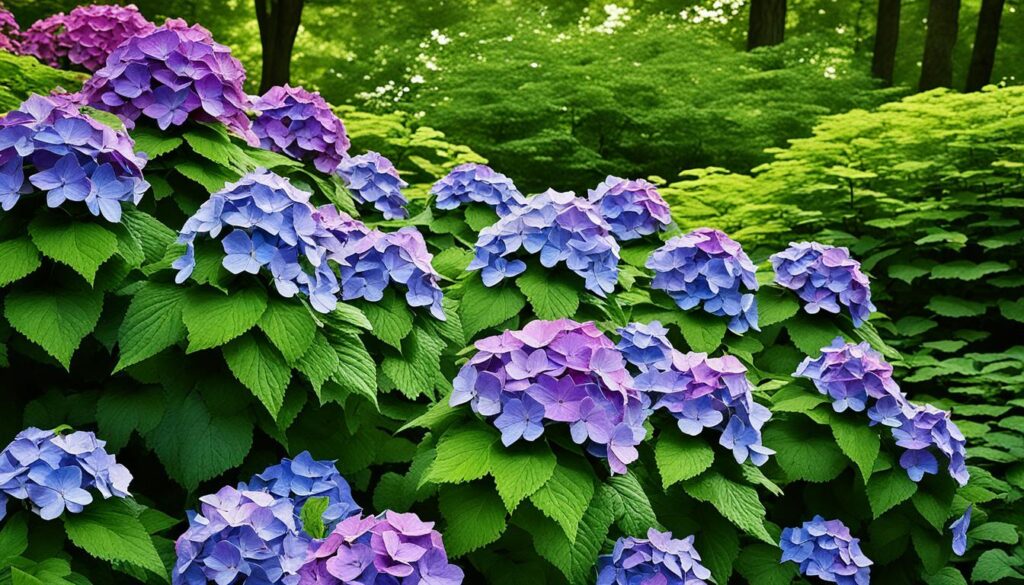
Pruning and Caring for Hydrangeas
Proper pruning and care are essential for the health and vitality of hydrangeas. By implementing appropriate pruning techniques and providing the necessary care, gardeners can ensure the longevity and abundant blooming of their hydrangea plants. Here are some important tips to consider:
Understanding Pruning Methods
When pruning hydrangeas, it’s crucial to understand whether the plant blooms on old wood or new wood. This knowledge will help gardeners avoid accidentally cutting off next season’s flowers.
Tip: Prune hydrangeas that bloom on old wood immediately after flowering. This allows for new growth and development of flower buds for next year. On the other hand, hydrangeas that bloom on new wood can be pruned during late winter or early spring before new growth begins.
Optimal Soil Conditions
Hydrangeas thrive in well-drained soil that is rich in organic matter. A mixture of compost and native soil is ideal for providing the necessary nutrients and moisture retention.
Fertilizing for Healthy Blooms
To promote healthy blooming, it’s recommended to fertilize hydrangeas with a slow-release fertilizer that is high in phosphorus. Phosphorus is essential for promoting flower production and overall plant vitality.
Preventing Leaf Scorch
Hydrangeas are susceptible to leaf scorch, especially during hot and dry periods. To prevent leaf scorch, it’s important to provide hydrangeas with extra water and ensure they have adequate moisture in the soil.

Summary of Pruning and Care Tips
| Pruning Method | Soil Conditions | Fertilizing | Preventing Leaf Scorch |
|---|---|---|---|
| Prune hydrangeas that bloom on old wood immediately after flowering | Well-drained soil with organic compost | Use slow-release fertilizer high in phosphorus | Provide extra water during hot and dry periods |
By following these pruning and care tips, hydrangea enthusiasts can enjoy lush, vibrant blooms year after year. With proper maintenance, these stunning plants will continue to beautify gardens and landscapes.
Conclusion
Planting hydrangeas in the best location and providing proper care and maintenance are key to achieving beautiful and vibrant blooms. By selecting the right spot that balances sun and shade, ensuring well-drained soil, and following recommended pruning and watering practices, gardeners can enjoy the full potential of their hydrangea plants. With the right planting and care, hydrangeas can transform any garden into a colorful and inviting space.FAQ
What is the best place to plant hydrangeas?
What are the best types of hydrangeas for morning sun and afternoon shade?
Can hydrangeas grow in full sun?
Which hydrangea varieties are best for full shade?
How should I prune and care for hydrangeas?
Are there any tips for planting and caring for hydrangeas?
- About the Author
- Latest Posts
Meet Katherine, the creative enthusiast at ByRetreat who infuses her boundless passion for design into every remote workspace she crafts. With an innate sense of creativity and an eye for unconventional beauty, Katherine brings a unique and inspiring perspective to the team.
Katherine’s love for design is infectious, and her ability to think outside the box sets her apart. She believes that true artistry lies in embracing a variety of styles and mixing them harmoniously to create captivating spaces. By combining different textures, colors, and patterns, Katherine weaves a tapestry of creativity that breathes life into each remote workspace.
Plants
Grow Zucchini Successfully: Best Way & Tips

Did you know that zucchini plants are susceptible to squash vine borers, a pest that can quickly kill the plants by cutting off the flow of water? The impact of these destructive borers can be devastating to your zucchini harvest. However, by following the best practices and tips for growing zucchini, you can ensure successful cultivation and enjoy a bountiful harvest.
Whether you are a seasoned gardener or a novice looking to try your hand at gardening, this article will provide you with valuable insights on the best way to grow zucchini and tips for successful cultivation. From avoiding squash vine borers to proper planting techniques, soil requirements, spacing, and pollination, we will cover everything you need to know to grow zucchini successfully.
Key Takeaways:
- Delay planting zucchini until mid-July or use row covers to prevent squash vine borers
- Start zucchini from seeds or seedlings and choose the right time to plant
- Provide well-draining soil enriched with organic material for optimal growth
- Space zucchini plants at least 3-4 feet apart and consider trellising for better air circulation
- Ensure proper pollination for optimal fruit production and harvest zucchini at any size
Planting and Germination
Zucchini, a popular summer squash variety, can be easily grown from seeds or seedlings. While starting zucchini indoors is an option, direct sowing in the ground is the preferred and most common method of planting zucchini seeds. Here’s a step-by-step guide to planting zucchini seeds and ensuring successful germination:
1. Prepare the Soil
Before starting zucchini indoors or sowing the seeds outside, it’s crucial to have well-prepared soil. Ensure the soil is loose, rich in organic matter, and drains well. Incorporating compost or aged manure can greatly improve the soil’s fertility. Measure the soil temperature and wait until it consistently reaches above 55 degrees Fahrenheit for successful germination.
2. Planting Zucchini Seeds
When the soil is ready, plant the zucchini seeds about an inch deep into the soil. Space the seeds at least 3 feet apart to allow ample room for growth. Lightly mist the top of the soil with water to ensure proper moisture levels for the germination of zucchini. Take care not to overwater the seeds, as it can lead to rotting.
Pro Tip: For those who prefer starting zucchini indoors, plant the seeds in peat pots or biodegradable seed starting trays about 2-3 weeks before the last expected frost. Transplant the seedlings outdoors once the soil temperature is suitable.
3. Germination and Thinning
The germination period of zucchini seeds typically ranges from 5 to 10 days. During this time, it’s important to keep the soil consistently moist but not waterlogged. Once the seedlings reach a height of around 3 inches and develop 2 sets of true leaves, it’s time to thin them out. Starting zucchini indoors often leads to more seedlings, so removing the weaker ones will allow the strongest ones to flourish.
4. Timing is Key
For optimal growth, it’s crucial to plant zucchini at the right time. Zucchini thrives in warm soil, so direct sowing should take place in the second half of May when the risk of frost has passed and the soil has warmed up. This timing ensures that the young seedlings will not succumb to cold temperatures.
“Direct sowing zucchini seeds is the most practical and successful method for home gardeners. The plants quickly establish themselves and produce abundant healthy foliage and fruit.” – Gardening Expert, Jessica Washington
By following these planting zucchini seeds and germination guidelines, you can give your zucchini plants a head start in their growth journey. Whether you choose to start the seeds indoors or directly sow them in the ground, with proper care and attention, you’ll soon be rewarded with healthy zucchini plants ready to produce an abundance of delicious squash.
| Benefits of Direct Sowing Zucchini Seeds | Benefits of Starting Zucchini Indoors |
|---|---|
| 1. Simplifies the planting process | 1. Provides an earlier start to the growing season |
| 2. Minimizes transplant shock | 2. Offers more control over seedling development |
| 3. Allows seeds to germinate and grow in their natural environment | 3. Enables better protection against adverse weather conditions |
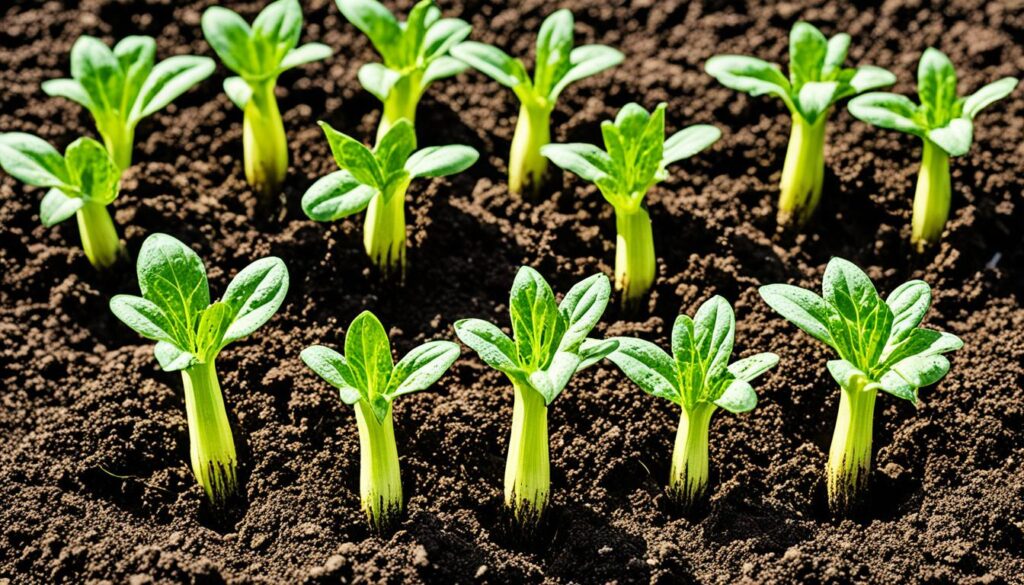
Soil and Location Requirements
Zucchini plants require specific soil and an ideal location to thrive and produce a bountiful harvest. Providing the right conditions for your zucchinis will ensure their health and productivity.
Choosing the Best Soil
Zucchini plants prefer organically rich, fertile, and well-draining soil. When planting in raised beds or containers, it is essential to select a well-draining potting soil. To enhance the soil’s fertility, add organic material or compost at the time of planting. This will help create a nutrient-rich environment for the zucchini plants to thrive.
If you are planting zucchinis directly in the ground, it is crucial to amend the soil with rich organic material or compost. This will improve the soil’s texture and provide the necessary nutrients for the plants to grow strong and healthy. Additionally, good drainage is essential for zucchini plants, as they prefer moist but not waterlogged conditions.
Choosing the Ideal Location
When selecting a location for your zucchini plants, it is important to consider their sunlight requirements. Zucchinis thrive in areas that receive full sun for at least 6-8 hours a day. Choose an area in your garden that is not shaded by buildings or trees, as this can hinder their growth and development.
Furthermore, it is important to note that zucchinis should not be planted in soil where other cucurbits (such as pumpkins or cucumbers) were grown in the past 1-2 years. This practice helps prevent the spread of diseases and pests that may affect the zucchini plants.
By providing the right soil conditions and selecting an ideal location with ample sunlight, you will create an optimal environment for your zucchini plants to flourish and produce an abundant crop.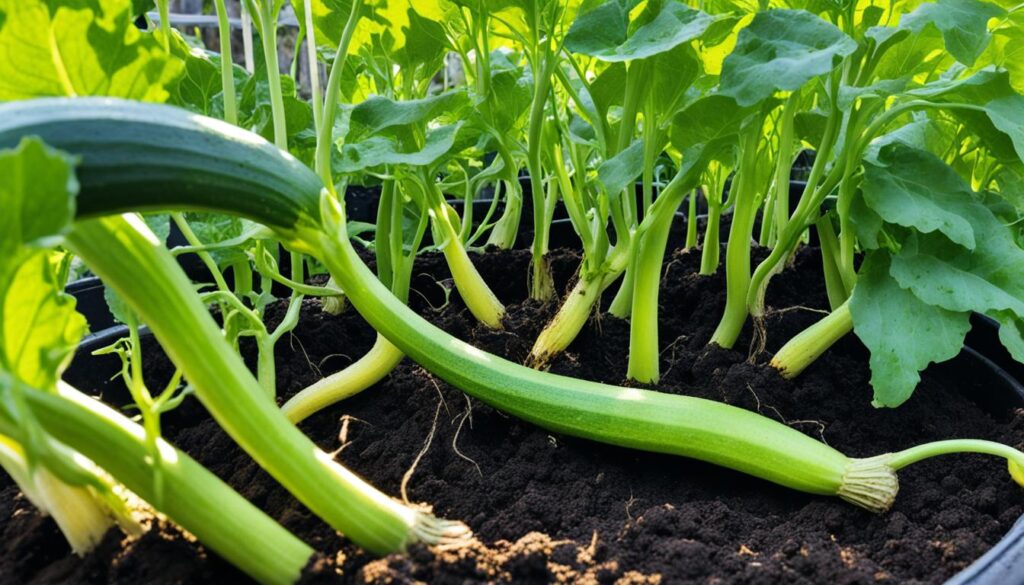
“Zucchini plants prefer organically rich, fertile, and well-draining soil. Provide the right conditions to help your zucchini plants thrive and produce a bountiful harvest.”
Spacing and Trellising
Proper spacing and trellising techniques are essential for the successful growth and development of zucchini plants.
Spacing Zucchini Plants
When it comes to zucchini plant spacing, giving enough room for each plant is crucial for optimal growth. It is recommended to space zucchini plants at least 3-4 feet apart, whether planting them in hills or rows.
For planting in hills, a general guideline is to plant 3 zucchinis per hill in a triangle pattern. Ensure the hills are also spaced 3-4 feet apart to provide enough space for the plants to receive nutrients and expand their root systems.
If growing zucchinis in containers, create a mound in the center of the container and plant three zucchinis around it. This arrangement allows for adequate airflow and efficient use of space while providing the plants with the necessary growing area.
Trellising Zucchini
Another option for maximizing space and aiding in pest management is trellising zucchini plants. By training them to grow vertically along a trellis or stakes, you can create a visually appealing and space-saving garden.
When trellising zucchini, ensure that the trellis or stakes are sturdy enough to support the weight of the plants and their fruit. As the zucchinis grow, gently guide the vines and tendrils toward the trellis, securing them with twist ties or plant clips.
The benefits of trellising zucchini include improved air circulation, which helps prevent disease, easier harvesting, and reduced pest damage since the plants are elevated off the ground.
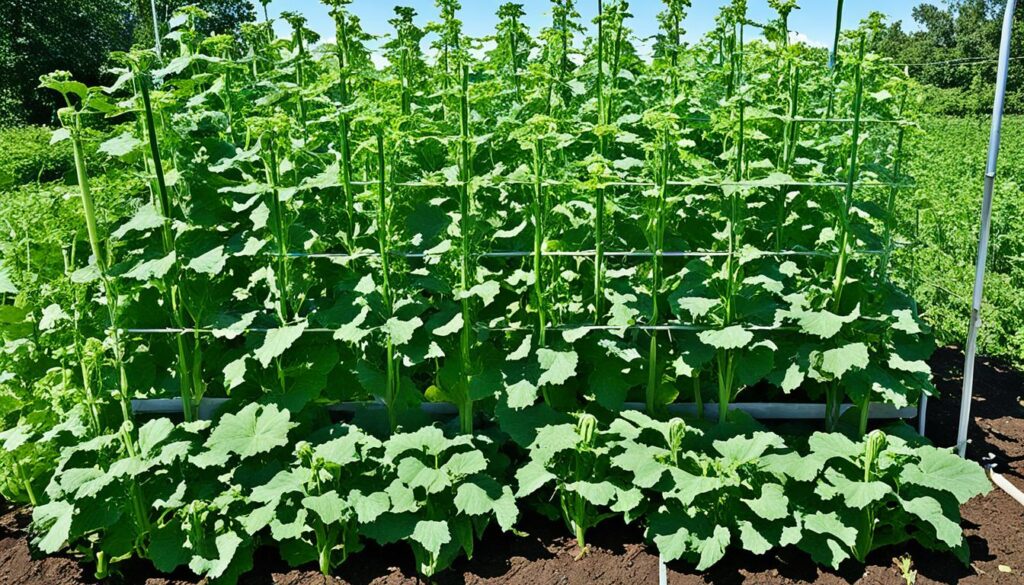
Implementing proper spacing and trellising techniques ultimately promotes healthier zucchini plants, increased productivity, and efficient use of garden space.
Pollination and Fruit Production
Zucchini plants rely on pollination for fruit production. These plants have separate male and female flowers, and the transfer of pollen from the male to the female flowers is crucial for the development of zucchini fruits. To ensure successful pollination, it’s important to understand how pollinators play a role in this process. 
Pollinators such as bees, butterflies, and other insects are attracted to the bright yellow flowers of zucchini plants. To maximize their presence in your garden, consider planting companion flowers like borage, catmint, dill, or dahlias nearby. These flowers will help attract pollinators, increasing the chances of successful pollination.
In some cases, there may be a lack of natural pollination due to factors such as weather conditions or a limited number of pollinators in the area. In such situations, manual pollination can be done to ensure fruit production. This process involves using a small brush or cotton swab to transfer pollen from the male flowers to the female flowers. By gently brushing the inside of the male flower and then transferring the pollen to the stigma of the female flower, you can help facilitate pollination.
Tip: To identify male and female flowers, look for the presence of a small zucchini-shaped swelling at the base of the female flower. Male flowers, on the other hand, do not have this swelling.
Proper pollination is essential for optimal fruit development. It ensures that the female flowers receive the necessary pollen for fertilization, leading to the formation of healthy zucchini fruits. Be sure to monitor the progress of your zucchini plants and check for signs of fruits developing from the female flowers.
When it comes to harvesting zucchini, you can do so at any size. However, larger zucchinis may have more developed seeds and a denser texture, which might not be desirable for certain recipes. In such cases, it is recommended to remove the seeds before consumption. This can be done by slicing the zucchini lengthwise and scooping out the seeds with a spoon.
Conclusion
Successful zucchini cultivation requires attention to several key factors, including avoiding squash vine borers, following proper planting techniques, providing the right soil and location, spacing plants correctly, and ensuring proper pollination. By implementing these tips and techniques, gardeners can enjoy a bountiful harvest of zucchinis that can be incorporated into a wide range of dishes.
The best way to grow zucchini is to start by carefully timing the planting, ensuring that soil temperatures are consistently above 55 degrees Fahrenheit. This warm soil temperature provides an ideal environment for germination and growth. Additionally, choosing a well-lit area with full sun for at least 6 hours a day will help zucchinis thrive.
When it comes to soil and location requirements, zucchini plants prefer organically rich and well-draining soil. Amend the soil with compost or rich organic material to promote healthy growth. Adequate spacing is essential for proper plant development, with a recommended distance of 3-4 feet between plants. Trellising zucchini plants can also save space and improve airflow.
Finally, ensuring proper pollination is crucial for maximizing fruit production. Planting companion flowers near zucchinis can attract beneficial pollinators, and manual pollination can be done to supplement natural pollination. Harvesting can be done at any size, but larger zucchinis may require seed removal before consumption.FAQ
When is the best time to plant zucchini?
How can I prevent squash vine borers from killing my zucchini plants?
What type of soil do zucchini plants prefer?
How should I space my zucchini plants?
Do zucchini plants require manual pollination?
Can I grow zucchini vertically?
- About the Author
- Latest Posts
Meet Katherine, the creative enthusiast at ByRetreat who infuses her boundless passion for design into every remote workspace she crafts. With an innate sense of creativity and an eye for unconventional beauty, Katherine brings a unique and inspiring perspective to the team.
Katherine’s love for design is infectious, and her ability to think outside the box sets her apart. She believes that true artistry lies in embracing a variety of styles and mixing them harmoniously to create captivating spaces. By combining different textures, colors, and patterns, Katherine weaves a tapestry of creativity that breathes life into each remote workspace.
Plants
Best Conditions for Ginger Root Growth Explained
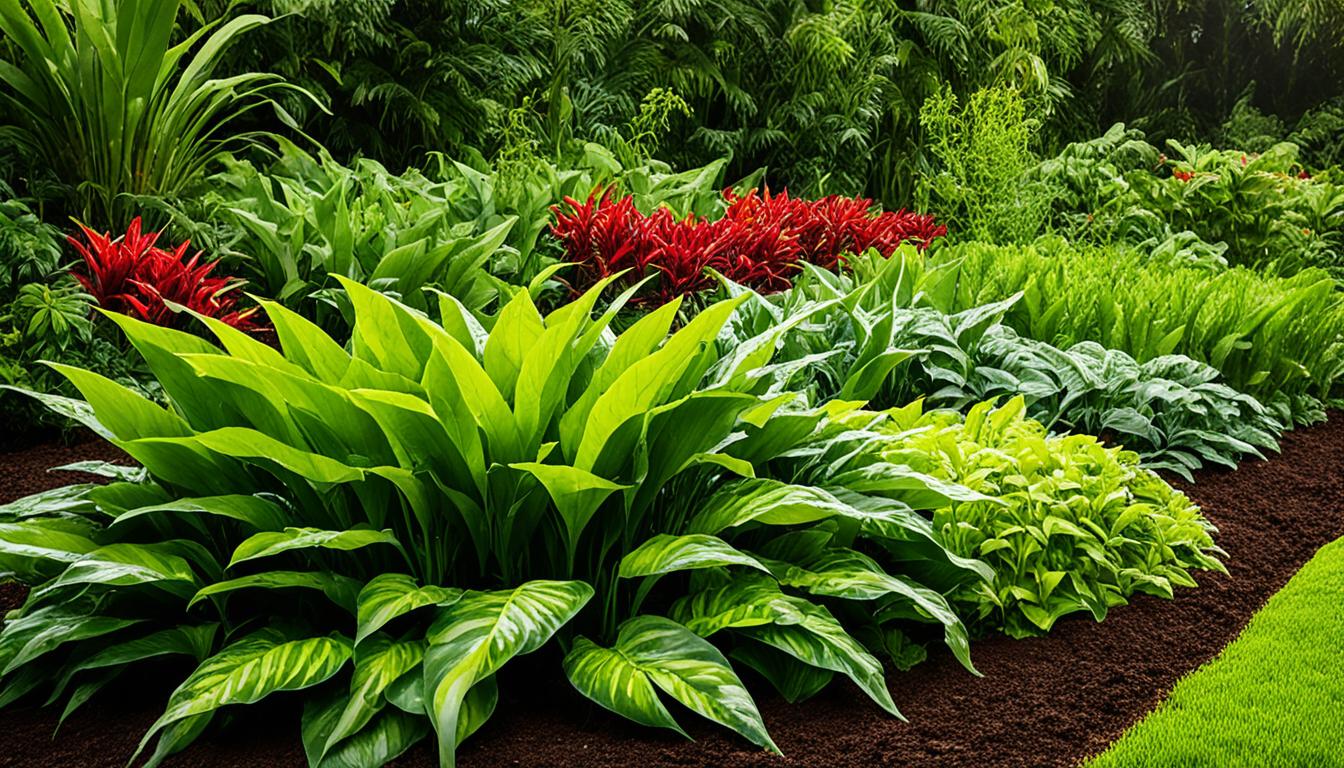
Ginger, known for its unique flavor and medicinal properties, is a versatile root used in everything from cooking to herbal remedies. But did you know that the success of ginger cultivation depends heavily on the conditions in which it is grown? Creating the best conditions for ginger root growth is essential to yield a bountiful harvest and vibrant plants.
From temperature to soil quality and moisture levels, each aspect plays a crucial role in ginger’s growth and well-being. By understanding the optimal conditions, gardeners and enthusiasts can replicate ginger’s tropical habitat and cultivate healthy plants with exceptional flavor and aroma.
In this article, we will explore the optimal conditions necessary for ginger root growth, offering insights and techniques to help you grow ginger successfully. Whether you’re an experienced gardener or a beginner with a green thumb, this guide will provide valuable knowledge to enhance your ginger cultivation.
Key Takeaways:
- Ginger root growth requires specific conditions to thrive.
- Temperature, soil quality, moisture, and shade are essential factors.
- Best practices include using organic matter, maintaining proper drainage, and providing dappled shade.
- Ginger can be grown in containers, hoop houses, or greenhouses.
- Pre-sprouting ginger indoors can maximize the growing season.
Optimal Soil Conditions for Ginger Root Growth
Ginger plants require optimal soil conditions to thrive and produce healthy root growth. By providing the right environment, gardeners can ensure that their ginger plants receive the necessary nutrients and support for robust growth. Here are some essential factors to consider when creating optimal soil conditions for ginger root growth:
- Rich in Organic Matter: Ginger prefers soil that is rich in organic matter, which provides essential nutrients and promotes healthy root development. Adding lots of compost to the ground or using a peat and wood bark-based soilless medium mixed with sand in containers can help create a fertile growing medium.
- Organic Fertilizers and Worm Castings: Supplementing the soil with organic fertilizers and worm castings can further enhance the nutrient content, ensuring that ginger plants have access to the necessary elements for their growth. These natural amendments provide a slow-release source of nutrients, promoting long-term plant health.
- Good Drainage: It is crucial to ensure good drainage in the soil to prevent waterlogging, as standing water can negatively affect ginger growth. To improve drainage, incorporating coarse sand or perlite into the soil can help create a well-draining environment for the roots.
- pH Levels: Maintaining the right pH levels is essential for optimal ginger growth. Ginger plants prefer slightly acidic soil, with pH levels between 5.5 and 6.5. Testing the soil’s pH and making appropriate adjustments using organic soil amendments or sulfur can help create the ideal conditions for ginger plants.
By creating soil conditions that are rich in organic matter, well-draining, and with the right pH levels, gardeners can provide the optimal environment for ginger root growth. The next section will explore the ideal temperature range for ginger plants and the impact it has on their growth and development.
Soil Conditions for Ginger Root Growth
| Soil Condition | Description |
|---|---|
| Rich in organic matter | Ginger prefers soil that is rich in organic matter, such as compost or a peat and wood bark-based soilless medium mixed with sand. |
| Organic fertilizers and worm castings | Adding organic fertilizers and worm castings can provide essential nutrients for ginger plants. |
| Good drainage | Ensuring good drainage in the soil is crucial to prevent waterlogging, which can negatively affect ginger growth. |
| pH levels between 5.5 and 6.5 | Maintaining slightly acidic soil with pH levels between 5.5 and 6.5 is ideal for ginger plants. |

Ideal Temperature Range for Ginger Root Growth
Ginger is a tropical plant that thrives in warm temperatures, making the ideal temperature range a crucial factor for its successful growth. The ideal temperature range for ginger root growth is 70° to 90°F (21° to 32°C). This range provides the optimal conditions for ginger plants to thrive and produce healthy rhizomes.
When growing ginger, it is important to consider the nighttime temperatures as well. It is recommended to plant ginger when nighttime temperatures are consistently above 55°F (13°C). Cooler temperatures can slow down the growth of ginger plants or even cause damage to them, hindering their development.
In regions with colder climates, it may be challenging to maintain these ideal temperatures for ginger growth. However, there are ways to overcome this obstacle and still grow ginger successfully. Growing ginger indoors in a controlled environment, such as a greenhouse or conservatory, can provide the necessary warmth for ginger plants to thrive.
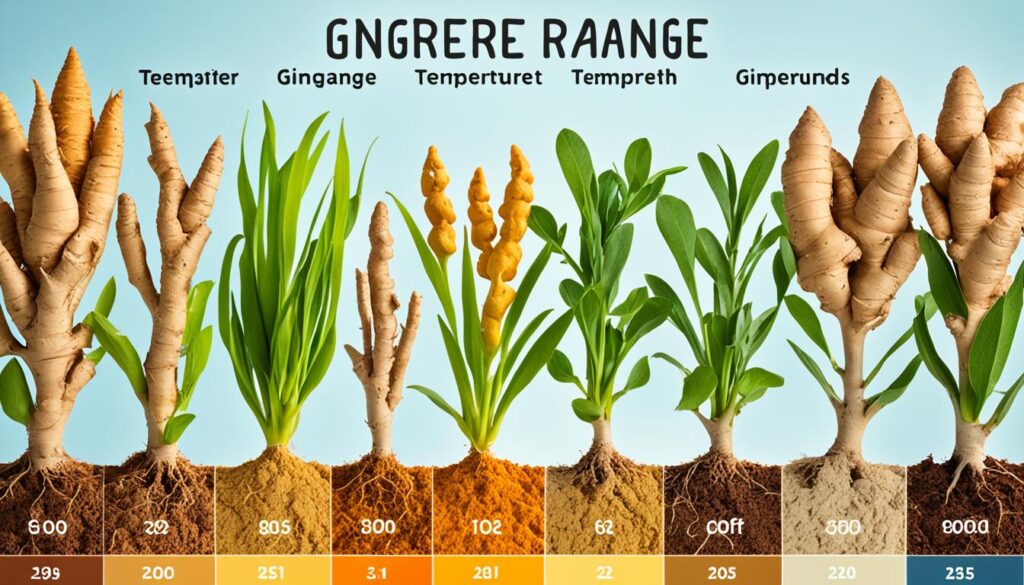
Importance of Moisture for Ginger Root Growth
Ginger is a moisture-loving plant that requires consistent watering to thrive and produce healthy and flavorful roots. Proper moisture management is essential for ginger root growth.
The soil should be kept evenly moist, providing enough water to meet the plant’s needs without overwatering or allowing the soil to dry out completely. Overwatering can lead to waterlogged conditions, which can suffocate the roots and promote the development of root rot. Conversely, letting the soil dry out completely can cause stress to the plant and hinder its growth.
Watering frequency may vary depending on factors such as the climate, humidity levels, and container size. In general, it is advisable to water ginger plants whenever the top inch of soil feels slightly dry. This allows for proper hydration without risking waterlogging.
Proper irrigation techniques and good drainage are crucial for maintaining the ideal moisture levels for ginger root growth. In containers, ensure that there are drainage holes to prevent water from pooling at the bottom. For in-ground planting, selecting a well-draining soil or amending the soil with organic matter can improve moisture balance.
Expert Tip:
When watering ginger plants, it’s important to give them a deep soak, allowing the water to penetrate the root zone. However, avoid overhead watering as it can lead to the development of fungal diseases. Instead, direct the water towards the base of the plant or use a drip irrigation system to ensure precise watering.
By maintaining the right moisture levels through proper watering techniques and good drainage, gardeners can provide the optimal conditions for ginger root growth, ensuring healthy plants and a bountiful harvest.

Moisture Guidelines for Ginger Root Growth
| Moisture Level | Signs | Recommended Action |
|---|---|---|
| Soggy or Waterlogged | Wilting, yellowing leaves; foul odor; root rot | Improve drainage by adding organic matter; reduce watering frequency |
| Too Dry | Wilting, dry soil; slow growth | Increase watering frequency; mulch around plants to retain moisture |
| Evenly Moist | Healthy foliage; steady growth | Continue regular watering; monitor moisture levels |
Benefits of Dappled Shade for Ginger Root Growth
Ginger plants thrive in dappled shade, which provides them with a balanced environment for optimal growth. The benefits of dappled shade include protection from direct sunlight, prevention of soil overheating and excessive drying, and maintenance of suitable moisture levels.
Planting ginger under the shelter of taller crops or using shade cloth can create the perfect conditions for ginger root growth. The dappled shade allows the plants to receive filtered sunlight, which is essential for photosynthesis while reducing the risk of sunburn or heat stress.
“Dappled shade is like a natural sunscreen for ginger plants, shielding them from the harsh rays of the sun and maintaining a cool, comfortable environment.”
By providing dappled shade, you can create an ideal microclimate for ginger root growth. The shade helps regulate soil temperatures, preventing it from becoming too hot and drying out too quickly. This is particularly important for ginger, as it prefers consistently moist soil.
Moreover, dappled shade helps to reduce water evaporation, allowing the roots to stay moist for longer periods. This helps the ginger plants establish a strong root system and absorb essential nutrients from the soil, promoting healthy growth and development.
When setting up dappled shade for your ginger plants, it is important to strike a balance. While providing shade, ensure that there is still enough light penetration for proper photosynthesis. Ginger plants need adequate sunlight to produce energy for growth, but too much direct sunlight can be detrimental.
Consider planting ginger in an area where it receives morning sun and partial afternoon shade. This allows the plants to benefit from the warmth and light of the morning sun while being shielded from the intense heat of the afternoon sun.
To summarize, dappled shade provides numerous benefits for ginger root growth, including protection from direct sunlight, prevention of soil overheating and excessive drying, and maintenance of suitable moisture levels. By implementing dappled shade techniques, you can create an ideal environment for ginger plants to thrive and produce a bountiful harvest.
Pros and Cons of Dappled Shade for Ginger Root Growth
| Benefits of Dappled Shade | Considerations for Dappled Shade |
|---|---|
| Protection from direct sunlight | Ensure there is still enough light for photosynthesis |
| Prevents soil overheating | Find a balance between shade and sunlight |
| Reduces soil drying out | Choose an area with morning sun and partial afternoon shade |
| Maintains suitable moisture levels |

Recommended Planting Techniques for Ginger Root Growth
When it comes to cultivating ginger, selecting the right planting technique is crucial for successful root growth. Whether using whole rhizomes or cut pieces, understanding the proper methods will optimize your ginger harvest. Here are some recommended planting techniques:
1. Using Whole Rhizomes
Planting ginger with whole rhizomes is a straightforward technique that yields excellent results. Look for healthy, plump rhizomes with well-developed buds or eyes. These larger rhizomes tend to grow quicker and produce more robust plants.
To plant whole rhizomes:
- Prepare the soil by loosening it with a garden fork or tiller.
- Dig a trench that is about 6 to 8 inches deep.
- Place the rhizomes in the trench with the eyes facing upwards.
- Cover the rhizomes with soil, ensuring they are well-buried but not too deep.
- Water gently to settle the soil.
2. Using Cut Rhizome Pieces
If you have limited planting material or want to maximize your ginger yield, using cut rhizome pieces is a viable option. When cutting the rhizomes, ensure each piece has at least one bud or eye.
To plant cut rhizome pieces:
- Prepare the soil or select a suitable container with good drainage.
- Fill the container with a well-draining potting mix or amend the soil with organic matter.
- Place the cut rhizome pieces in the soil or container, burying them about 1 to 2 inches deep.
- Water thoroughly to encourage root establishment.
Note: Make sure there is adequate room for the rhizomes to grow when planting in containers. This will prevent overcrowding and promote healthier plant development.
3. Pre-sprouting Indoors
For gardeners who wish to extend the growing season or gain a head start on ginger production, pre-sprouting indoors is an effective technique. This method involves placing the rhizomes in a tray with moist compost or paper towel to encourage early sprouting.
To pre-sprout ginger indoors:
- Select healthy rhizomes with visible eyes.
- Fill a tray with moist compost or lay paper towels on a flat surface.
- Place the rhizomes on the compost or paper towels, positioning them with the eyes facing upwards.
- Maintain the moisture level by misting regularly.
- Keep the tray or paper towels in a warm location with indirect sunlight.
- Once sprouts have developed, carefully transplant them into individual containers or directly into the ground.
Pre-sprouting allows for an earlier harvest and ensures that the ginger plants have a strong start before being exposed to outdoor conditions.
Remember, ginger responds well to a warm and humid environment, so providing the optimal conditions during the planting process will contribute to its overall growth and development.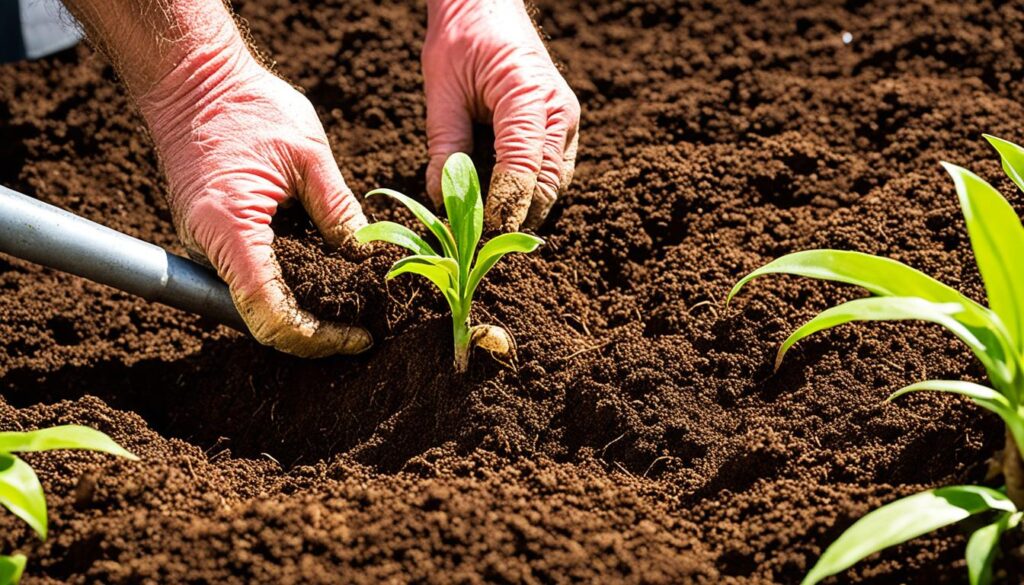
| Planting Technique | Advantages | Disadvantages |
|---|---|---|
| Using Whole Rhizomes | – Quicker growth – Larger harvests |
– Requires more planting material – Limited control over spacing |
| Using Cut Rhizome Pieces | – Maximizes planting material – Allows for precise spacing |
– Slower initial growth – Smaller rhizome yields |
| Pre-sprouting Indoors | – Provides an early start – Enhances germination rates |
– Requires additional indoor space – Requires regular misting |
Care Tips for Ginger Root Growth
Proper care is crucial for the successful growth of ginger roots. By providing the right conditions, you can ensure healthy plants and a bountiful harvest. Here are some essential care tips for ginger root growth:
1. Warmth: Ginger plants thrive in warm environments, so it’s important to provide them with a suitable temperature. During the summer, whether you are growing ginger outdoors or indoors, it’s beneficial to place the plants in a warm and humid area.
2. Humidity: Humidity is another important factor for ginger root growth. If you are growing ginger indoors, placing the plant near a bright windowsill can help simulate the ideal conditions. Additionally, occasional misting with water can create a humid environment that mimics the plant’s natural habitat.
3. Moisture: Adequate moisture levels are essential for ginger plants. It’s important to water the plants regularly, ensuring that the soil is evenly moist. However, be cautious not to overwater, as excessive moisture can lead to root rot. To promote proper drainage, use pots with drainage holes and allow the soil to dry out slightly between waterings.
4. Mulching: Applying a layer of mulch around ginger plants can serve multiple benefits. Mulching helps to conserve moisture in the soil, reducing the frequency of watering required. Additionally, it helps to suppress weed growth, keeping the area around the ginger plants clean and tidy.
Ginger plants require a combination of warmth, humidity, moisture, and proper drainage to thrive. By following these care tips, you can create optimal conditions for ginger root growth and enjoy a successful harvest.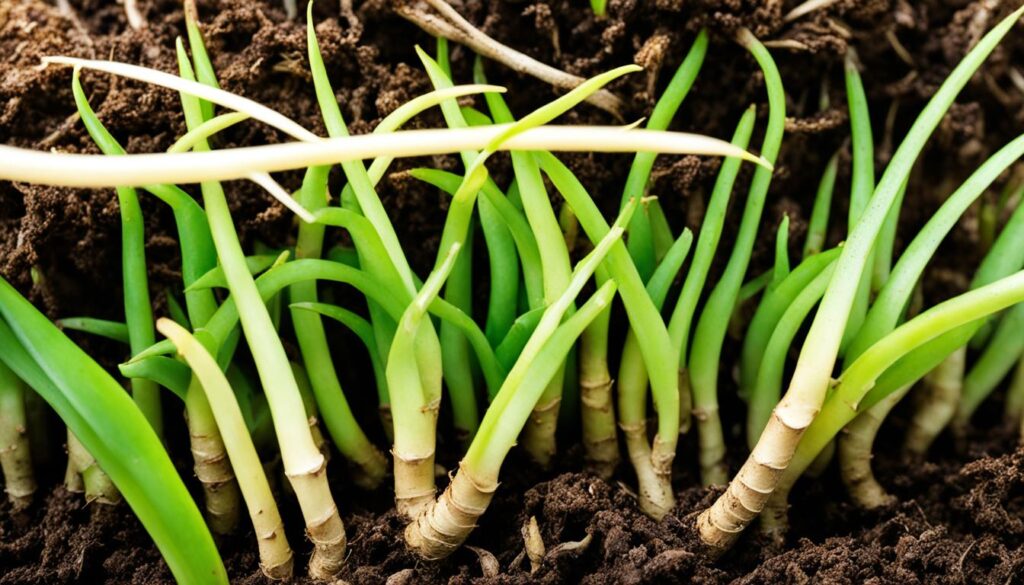
| Care Tips for Ginger Root Growth | Benefits |
|---|---|
| Provide warmth | Creates a favorable environment for ginger plants |
| Maintain humidity | Simulates the plant’s natural habitat and supports growth |
| Ensure proper moisture | Prevents drying out or waterlogging |
| Use mulch | Conserves moisture and suppresses weed growth |
Conclusion
Growing ginger successfully requires replicating its tropical natural habitat as closely as possible. Providing optimal soil conditions, the right temperature range, adequate moisture, and dappled shade is crucial. By following these best practices, gardeners can ensure the best conditions for ginger root growth and enjoy a bountiful harvest.
When it comes to planting ginger, there are two main methods: using whole rhizomes or cutting them into pieces and pre-sprouting indoors for an earlier harvest. Both approaches can be effective, but it’s important to pay careful attention to watering and drainage. Ginger cannot tolerate standing water or drying out completely, so finding the right balance is key.
Remember that ginger thrives in warm temperatures, ideally ranging from 70° to 90°F (21° to 32°C). Additionally, ginger plants appreciate some dappled shade, as it protects them from direct sunlight and helps prevent the soil from drying out too quickly. Creating these optimal conditions will give your ginger the best chance to grow and thrive.
So whether you’re growing ginger in the ground, in containers, or in a greenhouse, make sure to provide it with the right environment. By replicating its tropical natural habitat as closely as possible and paying attention to its specific needs, you can enjoy a bountiful harvest of delicious and aromatic ginger roots.
FAQ
What are the best conditions for ginger root growth?
What are the optimal soil conditions for ginger root growth?
What is the ideal temperature range for ginger root growth?
How important is moisture for ginger root growth?
What are the benefits of dappled shade for ginger root growth?
What are the recommended planting techniques for ginger root growth?
What are the care tips for ginger root growth?
- About the Author
- Latest Posts
Meet Katherine, the creative enthusiast at ByRetreat who infuses her boundless passion for design into every remote workspace she crafts. With an innate sense of creativity and an eye for unconventional beauty, Katherine brings a unique and inspiring perspective to the team.
Katherine’s love for design is infectious, and her ability to think outside the box sets her apart. She believes that true artistry lies in embracing a variety of styles and mixing them harmoniously to create captivating spaces. By combining different textures, colors, and patterns, Katherine weaves a tapestry of creativity that breathes life into each remote workspace.
-

 Vetted2 hours ago
Vetted2 hours ago15 Best Silver Polish Brands to Make Your Silver Shine Like New
-

 Vetted5 days ago
Vetted5 days ago15 Best Fillers for Concrete Cracks – Expert Recommendations and Reviews
-

 Vetted1 week ago
Vetted1 week ago15 Best Plants for Large Pots to Transform Your Outdoor Space
-

 Vetted6 days ago
Vetted6 days ago15 Best Fairy Lights to Transform Your Space With Magical Illumination
-

 Vetted1 week ago
Vetted1 week ago15 Best Folding Beds for Small Spaces – Space-Saving Solutions for Comfort and Convenience
-

 Vetted1 week ago
Vetted1 week ago15 Best Waterproof Flooring Options for Your Bathroom – Ultimate Guide & Reviews
-

 Vetted2 weeks ago
Vetted2 weeks ago15 Best Grocery Carts to Make Shopping a Breeze
-

 Vetted1 day ago
Vetted1 day ago15 Best Subfloor Options for Your Basement Renovation – Ultimate Guide





















